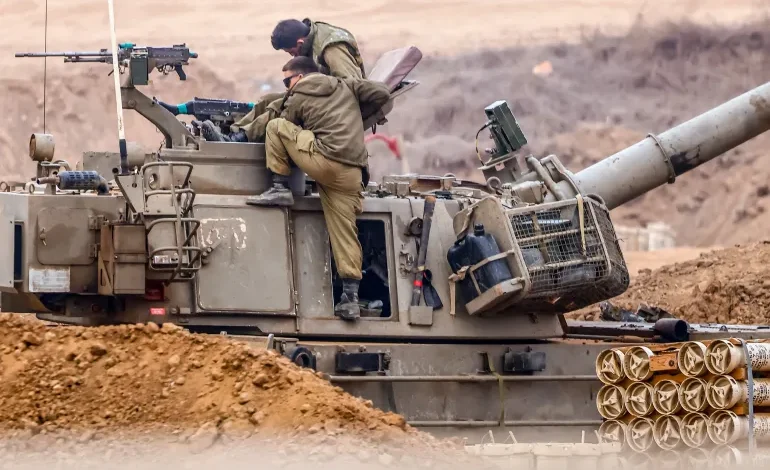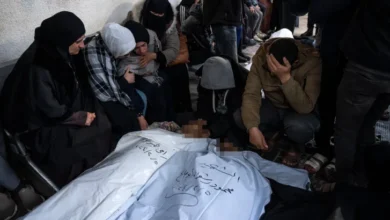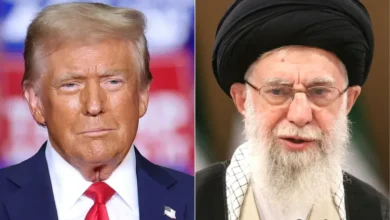What’s Israel’s Hannibal Directive? A former IDF soldier tells all

Yehuda Shaul describes his three years of service with the Israeli military, from 2001 to 2004, as the “most violent period” of the Israeli-Palestinian conflict up to that point.
The second Intifada (2000-2005), or Palestinian uprising, was at its crescendo and then-18-year-old Shaul was an infantry combat soldier; later, he was promoted to commander. The Jerusalem born and bred paratrooper served in the occupied West Bank for two years, and for a third year was stationed at Israel’s border with Lebanon.
Now 41, Shaul is a co-founder of the Israeli NGO Breaking the Silence, the first such organisation of Israeli military veterans calling for an end to the Israeli occupation of the West Bank, East Jerusalem and the Gaza Strip.
It was during his time stationed at the border with Lebanon that Shaul was first told about the Hannibal Directive, a former controversial Israeli military policy aimed at preventing the capture of Israeli soldiers by enemy forces – at any cost.
Israel last invoked it in 2014 during the war on Gaza that year, according to leaked military audio recordings, though the army denied it had used the doctrine. Dozens of Palestinians were killed in the Israeli bombardment that followed, sparking accusations of war crimes against the Israeli army.
But to Shaul, the Hannibal Directive made sense as a soldier of war.
So what exactly is it? And is the directive – which Israel is believed to have suspended in 2016 – relevant to Israel’s current bombardment of Gaza that has killed more than 9,000 people? The bombing followed the October 7 attack by Hamas on southern Israel in which more than 1,400 people were killed and at least 200 Israelis – including soldiers and civilians – were taken captive.
What is the Hannibal Directive?
The directive, also known as the Hannibal Procedure or Hannibal Protocol, is an Israeli military policy that stipulates the use of maximum force in the event of a soldier being kidnapped, said Shaul.
“You will open fire without constraints, in order to prevent the abduction,” he said, adding that the use of force is carried out even at the risk of killing a captive soldier.
In addition to firing at the abductors, soldiers can fire at junctions, roads, highways and other pathways opponents may take a kidnapped soldier through, Shaul said.
The Israeli military has denied the interpretation of the directive that allows for the killing of their fellow troops, but Israeli soldiers, including Shaul, have understood it as a licence to do just that, as it is preferred to a scenario in which a soldier is taken prisoner.
Shaul said that the directive was shared with him and other commanders orally. “I’ve never seen any written text of the rules of engagement,” he said.
According to Annyssa Bellal, an international lawyer who specialises in armed conflicts and international law, and senior researcher at the Geneva Graduate Institute, the directive was never an official policy and was therefore never published in its entirety.
“From a legal point of view, the directive is very controversial,” Bellal told Al Jazeera.
The aspect of the directive which risks killing a soldier is controversial under international law given that states must respect their citizens’ right to life, which is not a right lost even if they are captured by other states, she explained.
Where does it get its name?
The origins of the directive’s name are disputed, with some sources saying it is named after a Carthaginian general who chose to poison himself instead of falling captive to the Romans in 181 BC.
Israeli military officials, however, have said that a computer randomly generated the name.
Why was the directive created?
In 1986, Israeli army commanders drew up the doctrine after three soldiers from the Givati Brigade, an Israeli infantry brigade, were captured by the armed Lebanese group Hezbollah.
At that time, Israel occupied a southern region of the Levantine country in an area it created and called a security zone after its invasion of Lebanon in 1982. Hezbollah captured soldiers patrolling this zone, which would remain under Israeli occupation until 2000.
Members of the brigade saw a vehicle getting away with their captive fellow soldiers but did not open fire. The directive was created in response to ensure that never happened again.
The remains of the captured soldiers were returned to Israel 10 years later in 1996, in exchange for Israel returning the bodies of 123 Hezbollah fighters, according to the Israeli government.
Israel’s hardline stance since then is due to the fact that a soldier’s abduction is a strategic move for an enemy, Shaul said, giving them negotiating power, as well as the ability to affect both national morale and public support for a conflict.
Why not swap prisoners?
In 2006 Israeli soldier Gilad Shalit was seized by Hamas. After five years in captivity, he was eventually released in exchange for more than 1,000 Palestinian prisoners, the highest number of prisoners Israel released for one of its soldiers.
The release of Palestinian prisoners themselves was “seen as a humiliation and damaging the national honour” which put Israel in a state of national psychosis, said Uri Misgav, an Israeli journalist at Haaretz, in a 2016 Al Jazeera investigative documentary on the Hannibal Directive.
“That’s why we want to prevent [the capture of soldiers] at all costs, even at the cost of the death of the soldier,” said Shaul.
Following Shalit’s return, Israel began to arbitrarily arrest more Palestinians, including minors, in order to expand its assets for any future exchanges, wrote Eyal Weizman, a British Israeli architect and director of the research agency Forensic Architecture at Goldsmiths, University of London, in the November 2023 issue of the London Review of Books.
“All of this reinforces the perception that the life of one of the colonisers is worth a thousand times more than the lives of the colonised,” Weizman wrote.










